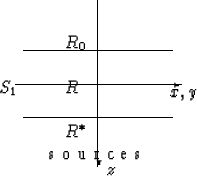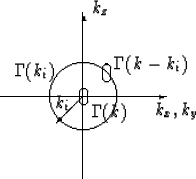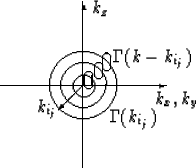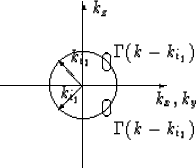 |
The volume integral representation of the Porter-Bojarski integral allows the backpropagation of the homogeneous portion in the measured data. We can not backpropagate the inhomogeneous portion. Nevertheless, if the inhomogeneous waves are weak in amplitude compared to the homogeneous waves, we can get a good subsurface image. Although we didn't use any weak scatterer approximation for the derivation of the Porter-Bojarski integral, the image obtained from the integral will not be complete if there are strong scatterers near our geophones. The seismic exploration industry solves this problem by cutting off evanescent energy and being content with the homogeneous wave image. It is more clever to continue downward the homogeneous waves to a certain reflector, let the reflector explode, and use the difference of synthetic and registered data to guess the evanescent energy and to update the reflection coefficients. This can be done iteratively.
Programming the Porter-Bojarski integral for the backpropagation from an
arbitrary surface S leads to an algorithm called
generalized holography. It performs the backpropagation of
homogeneous waves with a constant frequency.
Let us for a moment consider the Kirchhoff integral for
the special case
of a planar
registration surface S1.
We assume Cartesian coordinates and some scatterers only in the lower halfspace.
We construct a halfsphere S=S1 + S2 in the upper halfspace
with the x-y-plane being the
registration plane. If the radius approaches infinity,
we can ignore the energy scattered through the part of the
halfsphere with ![]() but not through the registration plane.
Remember that the Kirchhoff integral is zero
if we march from S1 towards the sources. Now subtract the wavefields from
a plane slightly above and parallel to S1 in a distance R0 and a
plane very close
but below S1 in a distance R* and also parallel to the observation plane
but not through the registration plane.
Remember that the Kirchhoff integral is zero
if we march from S1 towards the sources. Now subtract the wavefields from
a plane slightly above and parallel to S1 in a distance R0 and a
plane very close
but below S1 in a distance R* and also parallel to the observation plane
![\begin{eqnarray}
p(R,\omega) = \oint_{S_{1}} & [ p(R_0,\omega) ({\frac{\partial}...
...e {n}}}}p(R_0,\omega) (G(R-R^*,\omega)-G(R-R_0,\omega))] dS \ \ . \end{eqnarray}](img22.gif) |
||
| (11) |
| (12) |
If we add the integrals for above and below the observation plane, we get the Raleigh I integral
| (13) |
Equivalent Raleigh formulations for the Porter-Bojarski integral are obtained by inserting the conjugate complex Green's functions G*. If we consider the registration surface of reflection seismic surveys to be a plane, it will be sufficient to backpropagate only monopoles with a Raleigh II type representation of the Porter-Bojarski integral. We don't have to know the gradient of the wavefield. This shouldn't be news for you, but the explanations given for this fact by Schneider (1978) and others are rather heuristical.
Programming the Raleigh I or Raleigh II integrals leads to the so-called
Raleigh Sommerfeld Holography (Langenberg, K.L., 1986).
It performs the backpropagation of
homogeneous waves emitted by dipoles or monopoles
for constant frequencies.
 |
Until now we always considered holography in the ![]() space. Let us
study our problem in the frequency wavenumber domain. A homogeneous plane
wave is in the k-space located on the Ewald sphere (Ashcroft, N.W.,
Mermin, N.D., 1981).The
Ewald sphere is a sphere in the Cartesian k-space with the radius
space. Let us
study our problem in the frequency wavenumber domain. A homogeneous plane
wave is in the k-space located on the Ewald sphere (Ashcroft, N.W.,
Mermin, N.D., 1981).The
Ewald sphere is a sphere in the Cartesian k-space with the radius
| (14) |
To image we have to superpose as many intersections of Ewald spheres and object functions as possible to get a high resolution. There are basically two possibilities to get different intersections
 |
 |
Superposition of all possible backshifted intersections, i.e., a complete coverage of the k-space, yields to an ``optimal'' image with homogeneous waves. But we still miss the information of inhomogeneous waves due to strong scatterers or sources near the geophones.
Doing generalized holography or Raleigh Sommerfeld Holography for different frequencies leads to the frequency diversity filtered backpropagation algorithm:
Either frequency diversity or angular diversity can image the object if we have a complete coverage of the k-space. In practice, our data is bandpassed and registration on a plane limits the angular resolution. The seismic processing will be more sucessful if we can combine all the information we have. Prestack migration yields to better results than Zero-offset migration because the bandpassed frequency diversity of Zero-offset migration is completed by a limited angular diversity.
If our data is recorded on a plane, we should speak of the Raleigh Sommerfeld frequency diversity or angular diversity algorithms. For a constant velocity medium, Raleigh Sommerfeld angular diversity holography is nearly the same as diffraction tomography that will be studied in the next section.